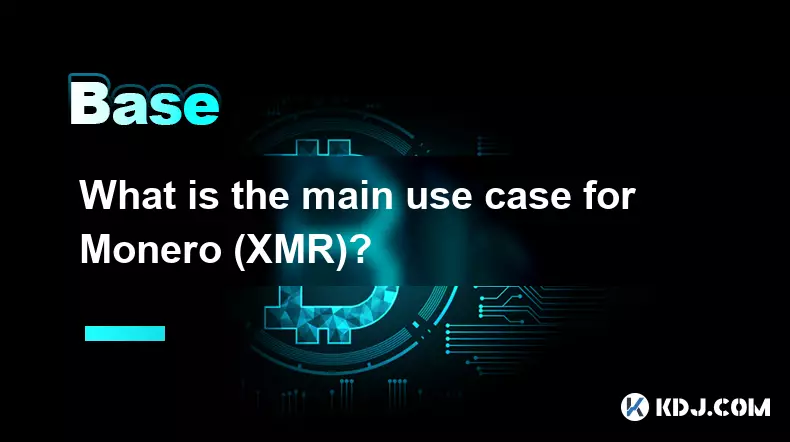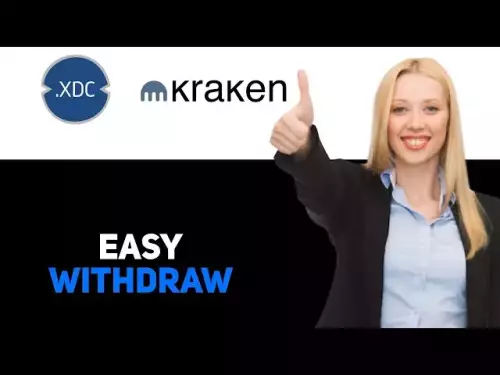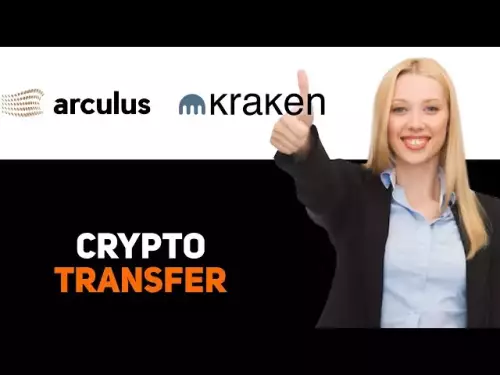-
 bitcoin
bitcoin $114684.631706 USD
-0.87% -
 ethereum
ethereum $4228.677447 USD
1.58% -
 bnb
bnb $1294.880693 USD
-1.16% -
 tether
tether $1.000819 USD
-0.02% -
 xrp
xrp $2.605138 USD
2.79% -
 solana
solana $209.908690 USD
5.89% -
 usd-coin
usd-coin $0.999903 USD
-0.03% -
 dogecoin
dogecoin $0.213423 USD
2.93% -
 tron
tron $0.322721 USD
-0.10% -
 cardano
cardano $0.727247 USD
3.66% -
 hyperliquid
hyperliquid $42.339456 USD
6.05% -
 chainlink
chainlink $19.910811 USD
5.16% -
 ethena-usde
ethena-usde $1.000557 USD
0.00% -
 stellar
stellar $0.349734 USD
2.69% -
 bitcoin-cash
bitcoin-cash $543.848687 USD
-0.21%
What is the main use case for Monero (XMR)?
Monero (XMR) ensures complete financial privacy using ring signatures, stealth addresses, and RingCT, making all transactions private by default.
Oct 13, 2025 at 05:55 am

Main Use Case of Monero (XMR)
1. Monero is primarily designed to provide complete financial privacy for its users, making it one of the most secure and anonymous cryptocurrencies available. Unlike Bitcoin, where transaction details are transparent and traceable on a public ledger, Monero uses advanced cryptographic techniques to conceal sender, receiver, and transaction amount.
2. Every transaction on the Monero network is private by default. This is achieved through technologies such as ring signatures, which mix a user’s transaction with others to obscure the origin; stealth addresses, which generate unique one-time addresses for each transaction to protect the recipient’s identity; and Ring Confidential Transactions (RingCT), which hide the transaction amounts.
3. Due to its strong privacy features, Monero is widely used in environments where financial confidentiality is critical. Individuals in regions with oppressive regimes or strict capital controls use Monero to protect their wealth and conduct transactions without government surveillance.
4. It also serves as a tool for ethical privacy advocates who believe financial data should not be publicly accessible. These users appreciate that Monero prevents companies, hackers, or third parties from tracking spending habits or balances simply by analyzing the blockchain.
5. Monero has gained adoption among darknet markets and privacy-focused services, although this represents only a fraction of its total usage. Its legitimacy extends beyond illicit applications, with growing interest from privacy-conscious developers, journalists, and human rights workers who require discretion in their financial interactions.
Decentralization and Resistance to Censorship
1. Monero operates on a fully decentralized network, ensuring no single entity can control or manipulate transactions. This decentralization strengthens its resistance to censorship, especially in jurisdictions where financial systems are tightly monitored.
2. The network's consensus mechanism relies on Proof of Work, using the RandomX algorithm optimized for CPU mining. This design choice promotes broader participation by preventing dominance from specialized mining hardware like ASICs, thus maintaining a more equitable distribution of mining power.
3. Because nodes cannot verify the true source or destination of funds, it becomes nearly impossible for authorities to blacklist specific addresses or freeze accounts. This feature enhances user autonomy and protects against arbitrary financial restrictions.
4. Exchanges and payment processors may delist Monero due to regulatory pressure, but the protocol itself remains unchangeable and immune to external interference. Users retain full control over their funds regardless of institutional policies.
5. The development team regularly updates the protocol to counter emerging threats and maintain long-term viability. These upgrades are community-driven and implemented without hard forks that could compromise continuity or trust.
Adoption in Privacy-Centric Applications
1. Several wallet providers and privacy tools integrate Monero as a preferred option for confidential transactions. These platforms cater to users seeking anonymity in peer-to-peer payments, donations, and cross-border remittances.
2. Non-governmental organizations operating in high-risk areas utilize Monero to securely transfer funds without exposing sensitive logistical information. This capability is crucial when supporting activists or delivering aid under restrictive conditions.
3. Some e-commerce sites accept Monero for goods and services, particularly those emphasizing digital rights, encryption tools, or independent media. These merchants value the reduced risk of customer data leaks compared to traditional payment methods.
4. Developers building decentralized applications (dApps) focused on privacy often incorporate Monero’s infrastructure or draw inspiration from its cryptographic model. Its open-source nature encourages innovation while upholding core principles of confidentiality.
5. Monero’s resilience against chain analysis makes it a benchmark for privacy in the cryptocurrency space, influencing how other projects approach fungibility and user protection.
Frequently Asked Questions
What makes Monero different from Bitcoin?Monero uses ring signatures, stealth addresses, and RingCT to ensure all transactions are private. Bitcoin transactions are transparent and can be traced on the blockchain, whereas Monero hides the sender, receiver, and transaction amount by default.
Can Monero be mined with a regular computer?Yes, Monero is designed to be mined efficiently on consumer-grade CPUs thanks to the RandomX algorithm. This allows individuals to participate in mining without expensive ASIC equipment, promoting decentralization.
Is Monero illegal to use?No, Monero is not inherently illegal. While some regulators have expressed concerns about its privacy features, owning and transacting in Monero is permitted in many countries. Users must comply with local laws regarding cryptocurrency usage.
How do I store Monero safely?Use official wallets like the Monero GUI/CLI wallet or trusted third-party options such as Feather Wallet or Cake Wallet. Always enable strong passwords, keep your seed phrase offline, and avoid sharing private keys.
Disclaimer:info@kdj.com
The information provided is not trading advice. kdj.com does not assume any responsibility for any investments made based on the information provided in this article. Cryptocurrencies are highly volatile and it is highly recommended that you invest with caution after thorough research!
If you believe that the content used on this website infringes your copyright, please contact us immediately (info@kdj.com) and we will delete it promptly.
- XRP Price Prediction: Weekend Rollercoaster or Rally?
- 2025-10-12 08:45:16
- Bittensor (TAO): Super Bullish Signals Point to Potential 2x Rally
- 2025-10-11 10:25:12
- Silver Price Correction: Navigating the Dip & Identifying Key SEO Keywords
- 2025-10-11 10:25:12
- Decoding Crypto Trends: Bittensor's Bull Run, Cardano's Dip, and LivLive's Presale Buzz in 'Uptober 2025'
- 2025-10-12 08:45:16
- MoonBull: The Crypto Meme Coin Promising 1000x Gains?
- 2025-10-11 10:30:01
- Crypto Payroll Revolution: Stablecoins, Altcoins, and the Future of Salary Payments
- 2025-10-11 10:30:01
Related knowledge

How do decentralized identity (DID) solutions work?
Oct 14,2025 at 11:36pm
Understanding Decentralized Identity in the Blockchain Ecosystem1. Decentralized identity (DID) solutions are built on blockchain networks, allowing i...

What does it mean for code to be "open source" in crypto?
Oct 12,2025 at 01:54pm
Understanding Open Source in the Cryptocurrency Ecosystem1. In the context of cryptocurrency, open source refers to software whose code is publicly ac...

What is the purpose of a "testnet"?
Oct 12,2025 at 09:01am
Understanding the Role of Testnets in Blockchain Development1. A testnet serves as a parallel version of a blockchain network, designed specifically f...

How to avoid phishing scams in crypto?
Oct 13,2025 at 06:18pm
Understanding Common Crypto Phishing Tactics1. Cybercriminals frequently use fake websites that mirror legitimate crypto exchanges or wallet platforms...

What is the difference between single-collateral and multi-collateral Dai?
Oct 12,2025 at 05:18pm
Understanding Single-Collateral Dai1. Single-Collateral Dai (SCD) was the original version of the Dai stablecoin launched by MakerDAO in 2017. It allo...

What is a "sidechain"?
Oct 13,2025 at 02:36pm
Understanding the Concept of Sidechains1. A sidechain is a blockchain that operates independently but is connected to another blockchain, known as the...

How do decentralized identity (DID) solutions work?
Oct 14,2025 at 11:36pm
Understanding Decentralized Identity in the Blockchain Ecosystem1. Decentralized identity (DID) solutions are built on blockchain networks, allowing i...

What does it mean for code to be "open source" in crypto?
Oct 12,2025 at 01:54pm
Understanding Open Source in the Cryptocurrency Ecosystem1. In the context of cryptocurrency, open source refers to software whose code is publicly ac...

What is the purpose of a "testnet"?
Oct 12,2025 at 09:01am
Understanding the Role of Testnets in Blockchain Development1. A testnet serves as a parallel version of a blockchain network, designed specifically f...

How to avoid phishing scams in crypto?
Oct 13,2025 at 06:18pm
Understanding Common Crypto Phishing Tactics1. Cybercriminals frequently use fake websites that mirror legitimate crypto exchanges or wallet platforms...

What is the difference between single-collateral and multi-collateral Dai?
Oct 12,2025 at 05:18pm
Understanding Single-Collateral Dai1. Single-Collateral Dai (SCD) was the original version of the Dai stablecoin launched by MakerDAO in 2017. It allo...

What is a "sidechain"?
Oct 13,2025 at 02:36pm
Understanding the Concept of Sidechains1. A sidechain is a blockchain that operates independently but is connected to another blockchain, known as the...
See all articles

























![[4K 60fps] Prisma by novichokk (1 Coin) [4K 60fps] Prisma by novichokk (1 Coin)](/uploads/2025/10/14/cryptocurrencies-news/videos/k-fps-prisma-novichokk-coin/68ee49804ba00_image_500_375.webp)
















































